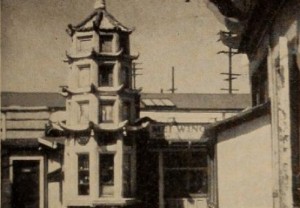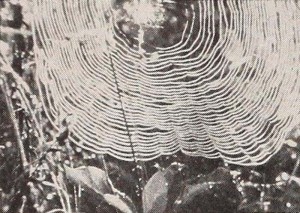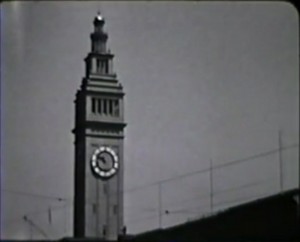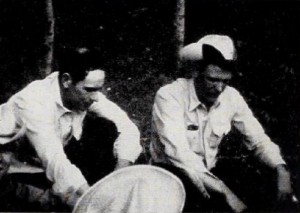"Among the ten best, Century of Progress, in Kodacolor, by Herbert H. Johnson, ACL, is a striking illustration of the degree of perfection that color motion picture photography has attained. Its studied angles and dignified composition are augmented by excellent photography. Mr. Johnson paid careful attention to the very important point of exact exposure in relation to color value and, as a result, brought a new version of the Fair to the one who had never seen it in color before. By taking plenty of time he was able to single out the best camera positions and wait for the lighting that was most favorable. The excellent handling of the camera brought a sense of intimacy to each scene. The film's only fault is an excessive use of lap dissolves which detracted somewhat from the smoothness of the continuity." Movie Makers, Dec. 1933, 499.
"A Century of Progress, the one reel record of the Fair in Kodacolor, by Edmund Zacher, II, ACL, is distinguished by the freshness of its dramatic treatment rather than by the faultless excellence of technique. In this latter field, Mr. Zacher, choosing to experiment along relatively unblazed color trails (slow motion, night photography, dissolves, etc.) has on occasion made slight errors, a fact which he himself is the first to admit. Dramatically, however, his film is a joy and a delight, replete with human interest, unhurried but unflagging in its presentation of the Fair from ever fresh viewpoints." Movie Makers, Dec. 1933, 523.

"A “city symphony” film, produced to encourage Photographic Society of America members to attend their 1963 conference in Chicago, City to See is a surprising film. It combines footage of Chicago with a deadpan commentary that pokes fun commercial travel films: “Chicago is my town,” the narrator says wryly, “and no other town will do.”" Chicago Film Archives

"An idol stolen from a Chinese temple and the efforts of a loyal retainer to recover it provide George Kirstein with a novel springboard for the unfolding of this unusual travel film. Subsequent events carry the principals from New York to Chicago, through the Southwest to Los Angeles and Hollywood, up the coast to San Francisco and finally back to New York for restoration of the idol. Far from hindering the sightseeing sequences, Mr. Kirstein's device enhances the presentation of this material. While the camera handling is satisfying throughout, tighter editing would speed up the pace and heighten dramatic interest." Movie Makers, Dec. 1949, 471.

"Combining the sensitivity of an artist and a camera skill that theoretically only professional experts could acquire, Robert P. Kehoe has produced, in Chromatic Rhapsody, a film that would command the amazed admiration of any movie club in the country. This beautiful picture can only be described as a scenic — a scenic held together rather tenuously by editing to create a symphonic arrangement of color and to associate scenes with the seasons. It is in the sheer beauty of color cinematography that Chromatic Rhapsody excels. This reviewer has never seen, in any medium, more gorgeous color photographs of autumnal foliage and winter landscapes. One is so impressed with the flawless color that he is inclined to suspect that nature puts on a special show for Mr. Kehoe. The truth is probably that Mr. Kehoe has a special understanding of nature and an intuitional sensitivity to light and color. For the rest, as Mr. Kehoe would say, he simply follows exposure instructions. The film is marred somewhat by lack of complete camera steadiness, the only flaw in an otherwise superb cinematic accomplishment. A charming musical score, arranged by double turntable, accompanies the movie's presentation." Movie Makers, Dec. 1939, 634.

"The City was entered by its maker as an experimental film and ended up winning the Travel Film Award. Usually travel motion pictures have a difficult time in festival competitions, but this one came out almost on top. George Hood, who also won an Honorable Mention for Goin' Home, shows you 17 minutes of San Francisco that makes you feel you have lived there all your life - and he does all this without one word of narration, just sounds and music plus excellent filming" PSA Journal, Oct. 1968, 48.
"Filmed in 1939 by the town doctor, Cologne is a personalized portrait of a farming community that merited only a single sentence in the WPA’s 1938 guidebook to Minnesota: “COLOGNE (945 alt., 355 pop.) is a German community named for the ancient city on the Rhine.” Dr. Raymond Dowidat and his wife, Esther, arrived in 1937 for his first practice after internship, and the impulse for the film seems to have arisen from their desire to document Cologne before they moved on to his next position in Minneapolis." filmpreservation.org
"When an experienced cameraman such as Oscar H. Horovitz turns his technically competent camera on attractive outdoor subject matter, attractive outdoor pictures are quite likely to result. When, in addition, such a producer lines to discipline his editing, inform his narrative, and make graceful his musical score, a motion picture of true charm and beauty will be his reward. Such is the happy combination which makes up Colonial Williamsburg. A thrifty thirteen-minute study of this handsome 18th Century capital." PSA Journal, 1954, 50.

"Seventeen hundred feet of 16mm. color is a lot of footage through which to sustain audience interest. But, so help us, that is exactly what Lester F. Shaal has done in Colorado Diary, and we don't quite understand yet just how he did it. Perhaps it was the diary-entry continuity device he used, which, with the entries being made in situ on a Colorado dude ranch, permitted a refreshing infusion of flash-back sequences amid the day-to-day activities. ("The flight out here was glorious," notes the attractive diarist, and some superb air footage lends variety to the routines of the corral.) Perhaps it was the side trips from the ranch to ghost mining towns — or to Durango and the narrow-gauge railway country. Whatever the secret, Mr. Shaal has mixed it well with his usually impeccable camera work. Seldom have the vitality and majesty of the West been portrayed more movingly than in Colorado Diary." Movie Makers, Dec. 1951, 410.
Total Pages: 23